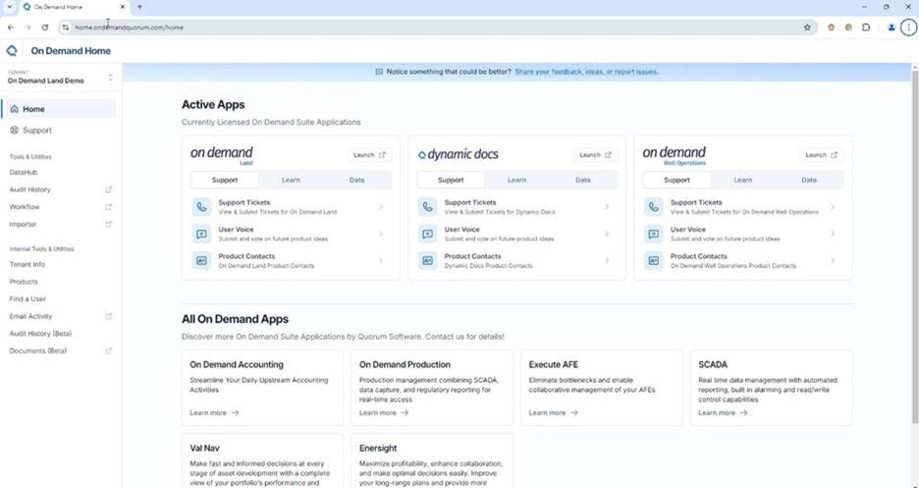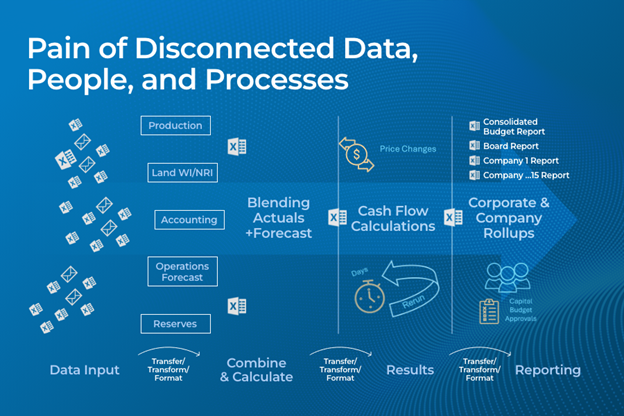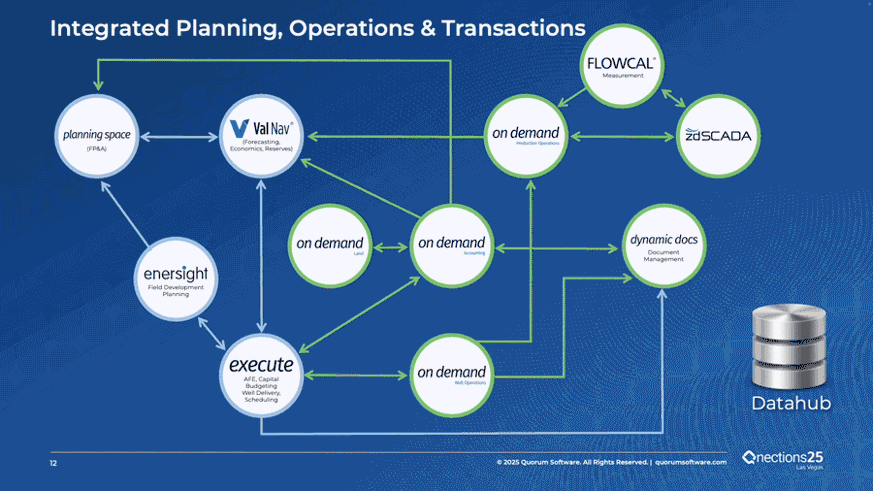What if every person across an upstream energy company—from field operations to the finance team—could work from one connected workspace that integrates land, accounting, production, reserves, operations, and planning? Where workflows no longer rely on spreadsheets, duplicate entry, or disconnected systems? Where real-time data flows freely and decision-making happens faster, with better outcomes?
That’s the North Star Vision behind Quorum Software’s integrated Upstream Suite. And for Venator Resources, that future isn’t hypothetical—it’s already here.
Venator Resources is a third-generation oil and gas operator, managing over 7,000 wells across five U.S. states through a network of 15 legal entities. Since 2019, they’ve grown production more than 3x—from ~2,000 BOE/d to ~7,500 BOE/d by 2025—and diversified operations with emerging initiatives. But with growth came complexity, and the realization that scaling through people alone wasn’t sustainable. The solution? Standardizing on Quorum’s digital core.
Today, Venator uses more Quorum solutions than any other customer, spanning both Planning, Economics & Reserves and the full Upstream On Demand product lines. In doing so, they’ve become a living case study in how to operationalize a vision of integrated planning and operations.
Hear directly from Berrhett Foss, Senior Accountant at Venator Resources, and Graham Kirk, VP of Solution Architects at Quorum, as they share Venator’s digital transformation journey—from challenges to outcomes—and the real impact of adopting a fully integrated Quorum suite.
Defining the Vision: A Digital Core for the Energy Business
Quorum’s vision is to make the Upstream Suite the daily command center for users, a platform that connects every critical workflow from field to finance. Built on modular, integrated workflows, the suite reflects the real-world structure and rhythm of upstream operations.
The suite spans workflows across the organization—connecting integrated transactions, operations, and planning. These capabilities can be grouped into four core categories:
- Transactions: Land, Accounting, AFE Management
- Operations: Production, SCADA, Well Operations
- Planning: Reserves, Forecasting, Capital Allocation, Field Development, Financial Planning
- Integrations: A shared data and document infrastructure powered by Data Hub and Dynamic Docs
Together, these components eliminate redundancies and manual handoffs. With GenAI, modern interfaces, and extensibility through BI tools and partner ecosystems, the suite delivers a single source of truth and a seamless user experience across roles, entities, and asset types.
For mid-market and growth-focused operators, the impact is transformative. And for Venator, it’s already translating into tangible business value.
“We implemented eight major Quorum solutions in under two years—and cut planning cycles from months to days.” — Berrhett Foss, Sr. Accountant at Venator Resources
A Unified Workspace That Brings Everything Together

The On Demand Home Page Dashboard brings everything together
One of the most recent additions to the Upstream Suite is the On Demand Home Page Dashboard. For customers like Venator managing multiple applications across teams, this centralized launchpad means users no longer need to remember different URLs or manage multiple logins. Instead, they start the day in one place, navigate to any licensed On Demand product instantly, and access support, training, and data modules right from the home screen.
This dashboard represents more than just UI convenience—it embodies the principle of connected workflows, making the entire suite feel like one cohesive system. It’s exactly the kind of frictionless experience Quorum is building toward.
Venator’s Challenge: Growth, Complexity, and Fragmentation
Venator’s growth trajectory brought with it a familiar challenge: complexity. By 2023, they had expanded rapidly but their technology stack hadn’t kept up. Critical data lived in spreadsheets and siloed systems. The same well name might be entered four times across reserves, production, and accounting. Reporting required scraping and stitching together data from multiple sources, with errors compounding across departments.

With 15 legal entities to manage, this fragmentation became a bottleneck. Budgeting took months. AFE approvals lived in email inboxes. Land documents lacked standardized tagging. Production teams entered the same data multiple times across different platforms. Reconciliations were manual and error prone. And preparing quarterly board reports ate up valuable weekends pulling data from disparate sources into a consolidation spreadsheet.
Simply put, Venator couldn’t scale any further without overhauling how their business ran.
The Solution: Standardizing on Quorum’s Upstream Suite
In 2023, Venator made a pivotal decision: to unify their operations on Quorum Software.
Their journey began with a migration from OGsql to On Demand Accounting, attracted by the benefits of a cloud-native solution that eliminated server maintenance and downtime.
From there, they added modules based on business need and integration value, implementing eight major solutions in under two years:
- On Demand Land for auditable lease and tract visibility.
- On Demand Production for field-level production data capture and automated allocations.
- Dynamic Docs for invoice automation and document control.
- Well Operations to close the loop from drilling to daily field reporting.
- Data Hub + EAG Foundations to centralize data and build real-time reporting dashboards.
- Val Nav to replace PHDWin and consolidate forecasting, economics, and reserves.
- Execute for budgeting, capital planning, and AFE workflows.
- Planning Space for consolidated multi-entity financial planning.
This was not a theoretical rollout. Venator went all in—implementing in parallel where integrations were critical, and hardening data as they progressed. And they did it largely in-house, with key support from Quorum and partners like EAG for top-layer reporting.
How the Suite Delivered
The outcome of Venator’s transformation is a tech stack that functions as a single, connected platform: Venator’s own realization of the Upstream Suite vision.

for planning, operations, and transactions.
Real-Time Reporting
With EAG Foundations layered on top of Quorum’s Data Hub, pulling from Val Nav, On Demand Accounting, and On Demand Production Operations, Venator can now generate LOS statements and financial dashboards instantly. Field teams and executives access the same data source, removing back-and-forth and data distrust.
Streamlined Capital Workflows
Execute replaced email-based AFE approval chains with automated routing, logging, and direct integration into Accounting. What once took weeks now happens in days—with full transparency and zero double entry.
Unified Forecasting & Planning
Planning Space loads operational forecasts from Val Nav, actuals from On Demand Accounting, and corporate data like G&A and debt to build full-entity rollups. Budget cycles that once took months now resolve in hours.
Operational Efficiency
With auto-allocations in On Demand Production Operations and structured well data in On Demand Accounting, Venator reduced production reporting staff from four to one—even while increasing well count.
Data Consistency at Scale
By aligning naming conventions across systems, enforcing data standards, and centralizing setup in On Demand Accounting, Venator eliminated inconsistencies that once plagued reconciliations and reporting.
The People Side of Change
Change management is often the hardest part of transformation. But Venator’s approach was grounded in transparency, ownership, and clear business outcomes. Department heads were engaged in defining master data rules. Staff received targeted training with Quorum’s help resources. And once the early wins (like faster LOS reporting and simplified AFEs) were realized, user resistance gave way to advocacy.
In fact, one of the most impactful outcomes has been improved collaboration. By removing silos, Venator saw a cultural shift—operations talking to accounting, engineering collaborating with finance. Data became the common language.
Looking Ahead: AI, Acquisitions, and Expansion
For 2025, Venator is focused on stabilization: running full cycles with the suite, identifying gaps, and continuing to strengthen data integrity.
But they’re also eyeing the future. GenAI-driven reconciliation is one area where they see significant potential to reduce manual accounting effort. And with more acquisitions on the horizon, the foundational work done in 2023–24 means future growth can be scaled without additional headcount.
Quorum’s continued investment in user experience, suite-level dashboards, and advanced automation will further cement this digital core. And for customers like Venator, that means less time firefighting and more time making strategic decisions.
From Vision to Reality
Venator Resources didn’t just adopt software. They adopted a new way of working, one that mirrors Quorum’s vision for the future of upstream oil and gas.
By implementing a unified suite across planning, operations, and accounting, Venator has:
- Scaled production 3x with minimal overhead
- Cut planning and reporting cycles from months to days
- Replaced dozens of manual processes with connected workflows
- Established a data infrastructure ready for AI-driven innovation
Venator’s journey proves how an integrated upstream platform can deliver measurable value across the business. In a market where efficiency, transparency, and agility define success, Venator stands as a gold-standard example of what’s possible when vision meets execution.
Want a quick summary to share with your team? Download the Venator Resources Case Study.
Ready to operationalize your own suite vision? Talk to our team to request a demo or explore Quorum's Upstream Suite in action.
 Previous Page
Previous Page